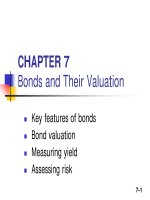New Products Management- CHAPTER 7 ANALYTICAL ATTRIBUTE APPROACHES: TRADEOFF ANALYSIS ppt
Bạn đang xem bản rút gọn của tài liệu. Xem và tải ngay bản đầy đủ của tài liệu tại đây (254.91 KB, 15 trang )
CHAPTER 7
CHAPTER 7
ANALYTICAL ATTRIBUTE APPROACHES:
ANALYTICAL ATTRIBUTE APPROACHES:
TRADE-OFF ANALYSIS
TRADE-OFF ANALYSIS
AND QUALITATIVE TECHNIQUES
AND QUALITATIVE TECHNIQUES
McGraw-Hill/Irwin
Copyright ©2006 The McGraw-Hill Companies, Inc. All right reserved.
Trade-Off (Conjoint) Analysis
Trade-Off (Conjoint) Analysis
Put the determinant attributes together
in combinations or sets.
Respondents rank these sets in order
of preference.
Conjoint analysis finds the optimal
levels of each attribute.
Thickness Spiciness Color Actual
Ranking*
Ranking as
Estimated
by Model
Regular Mild Red 4 4
Regular Mild Green 3 3
Regular Medium-Hot Red 10 10
Regular Medium-Hot Green 6 8
Regular Extra-Hot Red 15 16
Regular Extra-Hot Green 16 15
Thick Mild Red 2 2
Thick Mild Green 1 1
Thick Medium-Hot Red 8 6
Thick Medium-Hot Green 5 5
Thick Extra-Hot Red 13 13
Thick Extra-Hot Green 11 11
Extra-Thick Mild Red 7 7
Extra-Thick Mild Green 9 9
Extra-Thick Medium-Hot Red 14 14
Extra-Thick Medium-Hot Green 12 12
Extra-Thick Extra-Hot Red 17 18
Extra-Thick Extra-Hot Green 18 17
* 1 = most preferred, 18 = least preferred.
Conjoint Analysis Input: Salsa Example
Conjoint Analysis Input: Salsa Example
Figure 7.2
Regular Thick Ex-Thick
U
T
I
L
I
T
Y
2
1
0
-1
-2
Mild Medium-Hot Ex-Hot Red Green
Thickness Spiciness Color
0.161 0.913 -1.074 1.667 0.105 -1.774 -0.161 0.161
Conjoint Analysis: Graphical Output
Conjoint Analysis: Graphical Output
Figure 7.3
Conjoint Analysis:
Conjoint Analysis:
Relative Importance of Attributes
Relative Importance of Attributes
0 20 40 60 80 100 %
Spiciness
Thickness
Color
59.8%
34.6%
5.6%
Figure 7.3
(cont’d.)
Some Qualitative Attribute Analysis
Some Qualitative Attribute Analysis
Techniques
Techniques
Dimensional Analysis
Checklists
Relationships Analysis
There are many others.
A Dimensional Attribute List
A Dimensional Attribute List
Weight
Rust resistance
Length
Color
Water resistance
Materials
Style
Durability
Shock resistance
Heat tolerance
Explosiveness
Flammability
Aroma
Translucence
Buoyancy
Hangability
Rechargeability
Flexibility
Malleability
Compressibility
Figure 7.4
An Idea Stimulator Checklist for
An Idea Stimulator Checklist for
Industrial Products
Industrial Products
Can we change the physical/chemical properties
of the material?
Are each of the functions really necessary?
Can we construct a new model of this?
Can we change the form of power to make it work
better?
Can standard components be substituted?
What if the order of the process were changed?
How might it be made more compact?
What if it were heat-treated/hardened/cured/plated?
Who else could use this operation or its output?
Has every step been computerized as much as possible?
Figure 7.5
Templates for Creativity
Templates for Creativity
Attribute Dependency:
Find a functional dependency
between two attributes. Ex.: color of ink on coffee
cup is sensitive to heat and can reveal message if
coffee is too hot.
Replacement:
Remove a component and replace
with one from another environment. Ex.: antenna is
replaced by headphone cord on Walkman.
Displacement:
Remove a component and its
function to change the product. Ex.: Removing
floppy drives resulted in ultra-thin PCs.
Component Control:
Find a new connection between
a component internal to the product and one
external to the product. Ex.: Toothpastes with
whiteners, suntan lotions with skin moisturizers.
Figure 7.6
Source: Jacob Goldenberg and David Mazursky,
Creativity in Product Innovation
, Cambridge University Press, 2002.
Relationships Analysis
Relationships Analysis
Force combinations of dimensions (features,
functions, and benefits) together.
Techniques:
Two-dimensional matrix
Multidimensional (morphological) matrix
Two-dimensional example: person/animal insured
and event insured against.
Household cleaning products example used six
dimensions:
Instrument used, ingredients used, objects cleaned,
type of container, substances removed, texture or form
of cleaner
Another Form of Dimensional Analysis
Another Form of Dimensional Analysis
Two key dimensions for winning new
product ideas:
•
Utility lever:
How the product will affect
the customer’s life (such as simplicity,
fun/image, environmental friendliness,
reduced risk, convenience, and productivity).
•
Buyer’s experience cycle:
The stage
when/where the product will affect the
customer (purchase, delivery, use,
supplements, maintenance, disposal).
Figure 7.8
Source: W. C. Kim and R. Mauborgne, “Knowing a Winning Business Idea When You See One,”
Harvard Business Review
, Sept Oct. 2000, pp. 129-138.
Other Methods:
Other Methods:
Lateral Search Techniques
Lateral Search Techniques
Free association
Stereotype activity
Lateral thinking avoidance
Creative stimuli words
Studying “big winners”
Use of the ridiculous
Forced relationships
Lateral Thinking Avoidance
Lateral Thinking Avoidance
Keep an idea from dominating thinking as it
always has in the past by asking avoiding
questions.
Ask “Is there another way of looking at this?”
Ask “Why?”
Focus on an aspect of the problem other than
the “logical” one.
List all possible alternatives to every aspect of
the analysis.
Break apart aspects (concepts) of the problem,
or combine them to create even more concepts.
Some Creative Stimuli Words
Some Creative Stimuli Words
Guest stars
Alphabet
Truth
Outer space
Charity
His and hers
Style
Nation
Family
Videotape
Photography
Testimonials
Decorate
Fantasy
Hobbies
Holidays
Weather
Calendar
Push button
Snob appeal
Use of the Ridiculous
Use of the Ridiculous
How can you join two wires together?
Hold them with your teeth.
Use chewing gum.
Can you think of others?
Do any of these ridiculous ideas
suggest a not-so-ridiculous solution?









